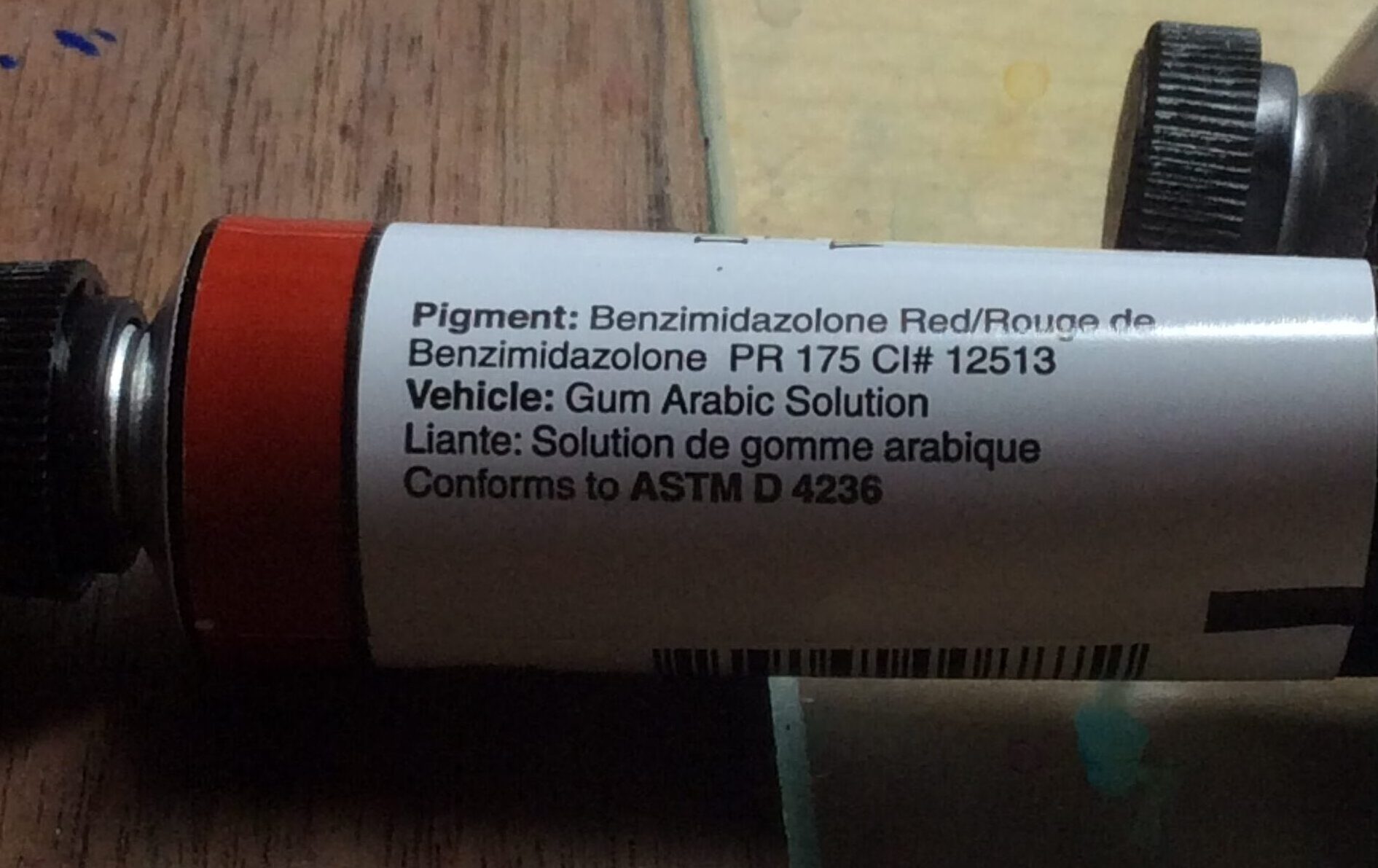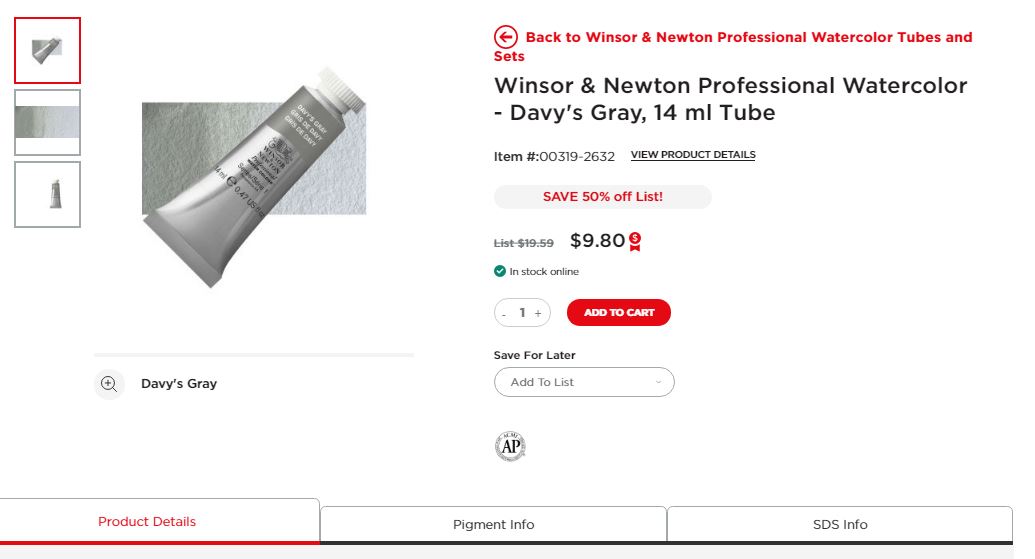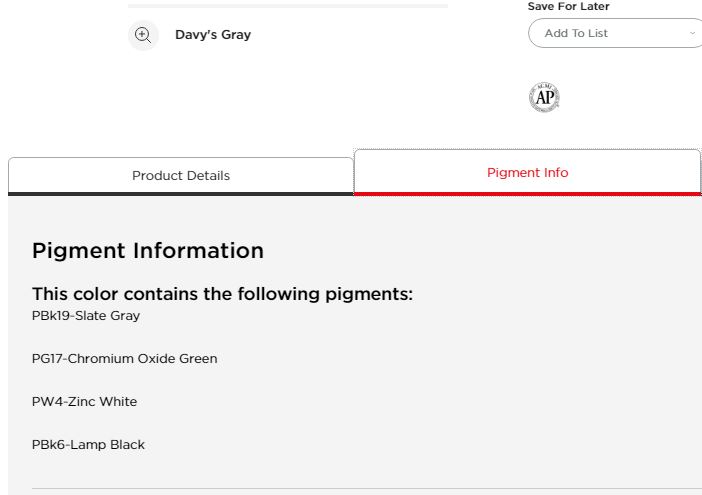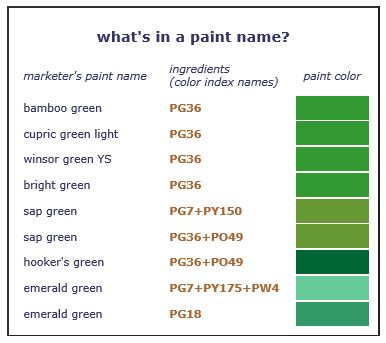What’s in Your Paint?
Knowing the contents of a paint can help you with a number of things:
- Make better decisions when buying new paint
- Figure out what paints you already have and avoid duplicating them with a paint that has a different name, but uses the same pigment
- Understand if a paint is single-pigment or a convenience mix, and how you can mix it yourself
- Determine if a paint is not really what the name of it says
- Discover/Recognize the characteristics of the paint
The names of artists’ paints are historical, eponymous, whimsical, chemical, and geographical – but mainly named to sell paint (The modern trend is to use chemically-derived names – to reflect the ‘scientific’ approach to paint.)
The Society of Dyers and Colorists (SDC) assigns a Color Index (CI) to each new pigment that comes on the market. The American Society for Testing Materials (ASTM) sets the standards of what must be on the label of a tube of paint, and one of those requirements is the CI code for the pigment(s) used in the paint. In order to get ASTM’s stamp of approval, each tube of must tell us exactly which pigment(s) it contains.
The CI (Color Index) is the true indication of what pigment you’re getting when you buy a tube of paint.
- Paint names and descriptions are often misleading – usually for a reason – to sell more paint to artists by using alluring names or by describing them in a romantic way. Many names of paints that no longer exist are still used. The CI is the only way to find out the actual pigment
- Most paints are single-pigment paints. That is they only contain one pigment – they will only have one CI.
- Some paints are mixes, often termed Convenience Mixtures. These will contain two or more CIs
- ‘Hues’, ‘New’, ‘Permanent’. If you see a term like this in the paint’s name, beware that its not the real McCoy. The manufacturers are constantly coming up with new modifying words to avoid having to admit the paint does not actually contain that pigment, and often they don’t add these modifiers unless they are called out by the ASTM. An example of this is ‘Cadmium Red Hue’. Cadmiums are expensive pigments, so many manufacturers will substitute other, less expensive, pigments. They are not supposed to call it ‘cadmium’, so they get by this restriction by calling ‘ Cadmium Hue’.
Pick up one of your tubes of paint and look at the label. Somewhere, you should see the CI. It can be identified as a short code starting with the letter ‘P’
- The ‘P’ stands for ‘pigment’. Occasionally you might run across an ‘N’ instead. This means a ‘natural’ and most often means it is made from something organic and has very poor light fastness.
- Right after the ‘P’ you will see a color initial (Yellow, Orange, Red, Blue, Violet, Green, Brown, Black, or White),
- this will be followed by a number assigned by the SDC. (1-3 digits)
- Example: PG 7 – commonly referred to as Phthalo Green, Blue Shade.
The photo to the right is the information on a tube of Daniel Smith ‘Deep Scarlet. You can see the pigment indicator is PR 175. This is Red Pigment #175 – Benzimidazolone. Obviously, ‘Deep Scarlet’ is a better choice for a name that reflects the color.

How do you find out more information about a particular pigment?
- Paint manufacturers’ sites.
- Online Stores: my favorite for information is www.DickBlick.com. If you are shopping for a paint online, look for a link to ‘more information’, or ‘pigment information’.
- Handprint. The watercolorist’s Bible. Bruce McEvoy wrote this site. He is a professional engineer and amateur watercolorist. The site is packed full of information about the physics of color, and the characteristics of watercolor paints. Unfortunately for us, Bruce has moved on to other endeavors, but his site lives on.
- Art Is Creation. This site stays current with all of the pigments (old, current, and new), but doesn’t have as much useful information for the watercolorist as Handprint
- Wet Canvas – it’s a big blog for Watercolorists. Often when you do an online search for something about watercolor, it will come up.
- A quick way to find out information about a particular pigment is to do a simple online search. Suppose we want more information about the PR 175 on the tube in the picture above. Type the following into your search engine: PR174 pigment. Include the word ‘pigment’. You will probably find a ton of information, as well as which manufacturers offer this pigment in a paint.

An excerpt from the Dick Blick site detailing ‘Davy’s Gray’ by W/N

The Pigment Information Tab
This figure shows how different paint manufacturers can have different names for the same pigments.
The first 4 paints in the list all have different names for the same pigment – PG36 – which is Phthalo Green, yellow shade. Despite the creative names, they all will be the same paint.
The next two are both ‘Sap Green’, but have different recipes. One uses PG36 and the other uses PG7. One mixes with a yellow (PY150), and the other with an orange (PO49).
Note that the second ‘Sap Green’, has an identical formula to ‘Hooker’s Green’. Based on the color swatch, there is more of the orange in the Sap. The pigment identifiers will not tell you the ratios.
One of the ‘Emerald Greens’ is a mix of green, yellow, and white, while the other is simply one pigment – Viridian (PG18).

Author: John D McLaren
May 5, 2022
